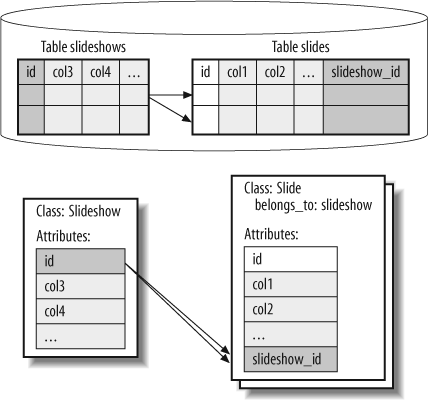We'll need to implement has_many relationships on both Photo and Slideshow. Figure 3-2 shows the mapping between Active Record objects and database tables with has_many.
Figure 3-2. The entity (slideshow) has_many associations (slides) relationship is a one-to-many relationship
has_many is the other side of a belongs_to relationship, so you don't need to modify the class or table for Slide. You can merely add the relationship has_many to slideshow.rb:
class Slideshow < ActiveRecord::Base has_many :slides end
And now, photo.rb:
class Photo < ActiveRecord::Base has_many :slides validates_presence_of :filename end
By specifying that a photo has many slides, you give users the ability to use the same photo in several different slideshows. Remember: a slide is a photo and a position in a specific slideshow. So a slide can't be reused, but a photo can.
That's all you have to do to manage the second side of the relationship. Now, you can to see all of the slides associated with a photo, and all of the slides in a slideshow. As usual, you can open the console to see the model in action:
>>slide = Slide.find 1... >>slideshow = slide.slideshow... >>slideshow.slides.each {|slide| puts slide.photo.filename}balboa_park.jpg camel.jpg cat_and_candles.jpg hut.jpg mosaic.jpg polar_bear.jpg police.jpg sleeping_dog.jpg stairs.jpg
So you get a list of slides in the slideshow, and each has an associated photo. Active Record is now managing the has_many relationship between Slideshow and Slide. You could use photo.slides in the same way. Table 3-2 shows you the metaprogramming for has_many.
Table 3-2. Metaprogramming for has_many
|
Added feature |
Description |
|---|---|
|
Methods | |
|
|
Add an object to the
|
|
|
Delete an object in the
|
|
|
Replace the
|
|
|
Uses the same rules as a basic find, but operates only on the items in the
|
|
|
Delete all of the objects in the association:
|
|
|
Test to see if
|
|
|
Return the number of items in the
|
|
|
Build an object of the associated type, but do not initialize it to the root object. It takes a hash map of attributes for the new object as a parameter:
In this example, |
|
|
Create an object of the associated type, initialized to the root object. It takes a hash map of attributes for the new object as a parameter:
In this example, |
|
Attributes | |
|
|
A collection of the associated objects:
|
